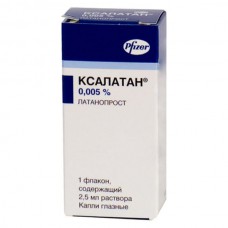Expiration date: 09/2025
The composition and form of issue:
Eye drops, 1 ml contains:
latanoprost 50 micrograms
auxiliary substances: sodium chloride sodium dihydrogen phosphate (monohydrate) sodium hydrogen phosphate (anhydrous) benzalkonium chloride water for injections
in vials-droppers of 2.5 ml in a cardboard pack of 1 or 3 vials.
Description pharmaceutical form:
Clear, colorless solution.
Pharmacokinetics:
Suction. Latanoprost, being a Pro-form that is absorbed through the cornea where it is hydrolysis to the biologically active acid. Concentration in watery moisture reaches a maximum approximately 2 h after topical application.
Distribution. Vd is (0,16±0,02) l/kg. Acid latanoprosta defined in watery moisture during the first 4 hours and in plasma only during the first hour after local administration.
Metabolism. Latanoprost, being a Pro form that undergoes hydrolysis in the cornea under the action of esterases with the formation of the biologically active acid. Acid latanoprosta entering the systemic circulation is metabolized primarily in the liver by beta-oxidation of fatty acids with the formation of the 1,2-dinor - and 1,2,3,4-tetranor-metabolites.
Excretion. Latanoprost acid is rapidly eliminated from plasma (T1/2 =17 min). Systemic clearance is approximately 7 ml/min/kg After beta-oxidation in the liver metabolites are excreted mainly by the kidneys (after local administration with urine output approximately 88% of the administered dose).
Description pharmacological action:
Latanoprost is an analogue of PGF2&alpha — is a selective FP receptor agonist and lowers intraocular pressure (IOP) by increasing outflow of aqueous humor, mainly through the uveoscleral and also through the trabecular meshwork. Reduction of IOP starts approximately 3-4 h after drug administration, the maximum effect is reached after 8-12 h, the effect persisted for at least 24 h.
Found that latanoprost has no significant effect on products watery moisture and gematoentsefalichesky barrier.
When used in therapeutic doses, latanoprost has no significant pharmacological effect on the cardiovascular system and the respiratory system.
Indications:
Reduction of elevated IOP in patients with open-angle glaucoma or high IOP.
Contraindications:
hypersensitivity to latanoprost or other components of the drug
the age of 18.
With caution:
the aphakia, pseudophakia with rupture of the posterior lens capsule
patients with known risk factors for macular edema (when treating latanoprost described cases of macular edema, including cystoidea) inflammatory, neovascular or congenital glaucoma (due to the lack of sufficient experience with the drug).
Application of pregnancy and breast-feeding:
Adequate controlled studies in pregnant women have not been conducted. The drug should be administered during pregnancy only in those cases where the potential benefit to the mother outweighs the potential risk to the fetus.
Latanoprost and its metabolites may be released into breast milk, so during lactation the drug should be used with caution.
Side effects:
Was the following adverse reactions related to the use of the drug:
On the part of the organ of vision: eye irritation (burning sensation, feeling of sand in eyes, itching, stinging and foreign body sensation) blepharitis conjunctival hyperemia eye pain, increased pigmentation of the iris transient point of erosion of epithelium, swelling of the eyelids, swelling and erosion cornea conjunctivitis lengthening, thickening, increased numbers and increased pigmentation of eyelashes and vellus hair changing the direction of eyelash growth, sometimes causes irritation of the eye iritis/uveitis keratitis macular edema, including custody blurred vision.
On the part of the skin and subcutaneous tissue: rash, darkening of the eyelid skin and local skin reactions on the eyelids.
From the nervous system: dizziness, headache.
From the side of respiratory system: asthma (including acute attacks or exacerbation of the disease in patients with bronchial asthma in history), shortness of breath.
From the side of musculoskeletal system and connective tissue: pain in muscles/joints.
Nonspecific responses: nonspecific chest pain.
Drug interactions:
With the simultaneous instillation into the eyes of two analogs of PG described the paradoxical elevation of IOP, so the simultaneous use of two or more of PG, their analogues or derivatives is not recommended.
Farmatsevticeski incompatible with eye drops containing thiomersal — precipitation.
Method of application and dose:
Adults (including the elderly) 1 drop in affected eye(s) 1 times per day. Optimal effect is achieved when using the drug in the evening.
Overdose:
Symptoms: in addition to mucous membrane irritation of eyes, redness of the conjunctiva or episclera, other undesirable changes in the organ of vision in overdose latanoprost not known.
If you accidentally taking latanoprost inside, note the following information: 1 vial with 2.5 ml of solution contains 125 µg latanoprost. More than 90% of drug is metabolized in the first pass through the liver. The on/in infusion at a dose of 3 mg/kg in healthy volunteers did not cause any symptoms, but with the introduction of a dose of 5.5–10 µg/kg were observed nausea, abdominal pain, dizziness, fatigue, hot flashes and sweating. In patients with bronchial asthma of moderate severity introduction latanoprost in the eye in a dose, in 7 times the therapeutic does not cause bronchospasm.
Treatment: in case of overdose, symptomatic treatment.
Special instructions:
The drug is Xalatan, you should not apply more than 1 time per day, as more frequent administration latanoprost leads to a weakening of the IOP reducing effect.
When skipping one dose, the next dose should be administered at the usual time.
Latanoprost can be used in conjunction with other ophthalmic drugs for topical application to decrease IOP. If the patient is simultaneously use other eye drops, they should be used with interval of at least 5 min.
The preparation includes Xalatan benzalkonium chloride which may be absorbed by contact lenses. Before eyedrops contact lenses, you must remove and re-install them after 15 minutes.
Latanoprost may cause a gradual increase in the content of brown pigment in the iris. Change the eye color due to increased melanin content in stromal melanocytes of the iris, not the increase in the number of melanocytes themselves. In typical cases, the brown pigmentation appears around the pupil and spreads concentrically to the periphery of the iris. The entire iris or parts of it become brown. In most cases the color change is slight and may not be established clinically. Increased pigmentation of the iris of one or both eyes has been observed mainly in patients with mixed colour irides that contain the basis of brown color. The drug has no effect on nevi and lentigo iris pigment accumulation in the trabecular network or in the anterior chamber was not noted.
In determining the degree of pigmentation of the iris for more than 5 years revealed no undesirable effects of increased pigmentation even with continued therapy latanoprost. Patients the degree of reduction of IOP was similar, regardless of the presence or absence of increased pigmentation of the iris. Therefore, treatment with latanoprost can be continued in cases of increased pigmentation of the iris. Such patients should be under regular supervision, and, depending on the clinical situation, treatment may be discontinued.
Increased pigmentation of the iris is usually observed during the first year after initiation of treatment, rarely during the second or third year. After the fourth year of treatment this effect was not observed. The rate of progression of pigmentation decreases with time and stabiliziruemost after 5 years. In a more long-term effects of increased pigmentation of the iris has not been studied. After stopping treatment enhance brown pigmentation of the iris is not mentioned, however, change the color of the eyes can be irreversible.
In connection with the use of latanoprosta described cases of darkening of the eyelid skin which may be reversible.
Latanoprost may cause a gradual change in eyelashes and vellus hair, such as lengthening, thickening, increased pigmentation, increased thickness and changing the direction of eyelash growth. Eyelash changes are reversible and disappear after cessation of treatment.
In patients, applying drops only in one eye may develop heterochromia.
The use of eye drops may cause transient blurring of vision.
Effect on ability to drive and control mechanisms. During application of the drug should be used with caution.
Storage conditions:
After opening at temperature not exceeding 25 °C for 4 weeks.



